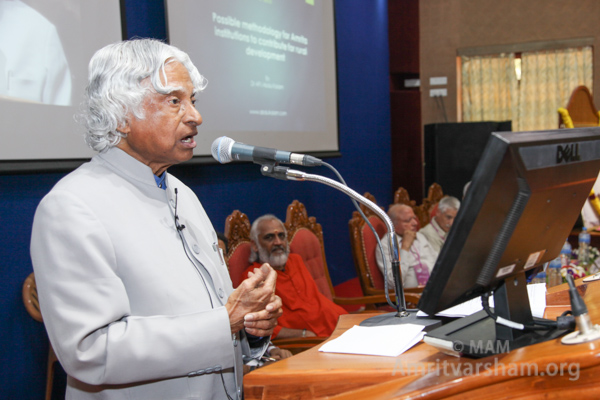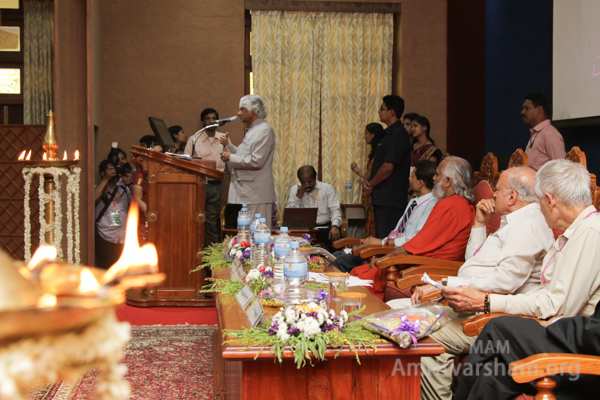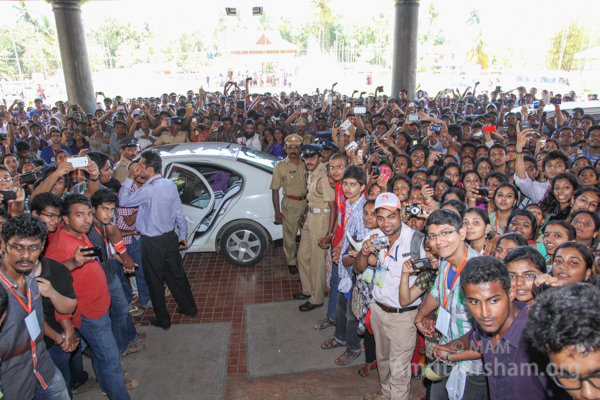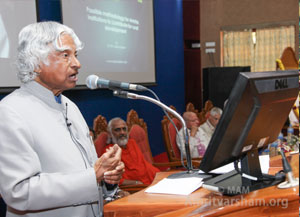25 Sep 2013, Amritapuri – Amritavarsham60 Celebrations
Dr. APJ Abdul Kalam’s address at the International Summit – “Our villages, Our World: What can we Offer?”
(excerpts from his inaugural address)
I am delighted to participate and deliver a key note address to the International Summit “Our villages, Our World: What can we offer?” jointly organised by Amritanandamayi Math and Amrita University.

I am happy to know that, the International summit is going to brainstorm on the topics such as: Science and Technology, Health and Public Hygiene, Education and Human values, Business and Entrepreneurship, Governance and Administration targeting towards transforming villages into sustainable and integrated communities. In this context, let me share my thoughts on the subject “Possible methodology for Amrita institutions to contribute for rural development.”
Global Challenges
Today, the challenges of the world are poverty, illiteracy, safe drinking water, clean and green energy, equitable distribution of resources, quality education with values for all, overcoming societal imbalances, quality healthcare for all and good living conditions. Individual nations are working to find a solution to these challenges.
When nations start working on the common enemies of illiteracy, poor health care etc, their tendency to focus on national, regional and global peace with better mutual trust is enabled. The global challenges take various manifestations based on the local dynamics which are interconnected by various factors.

Sustainable development can challenge the Global crisis
Particularly, if we focus on India, it has 600,000 villages where 70% of the people are living. In the entire world, 3 billion people are living in the rural areas.
Driven by the need of education, healthcare and better income, the rural population is migrating to urban areas with a hope to get a better chance to opportunities, but they often meet with despair. This further contributes to urban poverty as well as leading to stresses and societal turbulence.
The rural areas of the world, occupy a position where there are unharnessed resources and potential. They have youth and traditional skills which have to be nurtured into value adding enterprises leading to an environment of empowerment. How can such a mission of Empowering 3 Billion be realized? It would indeed require out of the box thinking and ideas previously un-conceived.
If we empower the Indian villages with sustainable development agenda, then certainly India can sustain and grow in spite of any kind of global economic crisis or turbulence situation faced in future.
Sustainable development for India’s villages
Sustainable development refers to a mode of human development in which resource use aims to meet human needs while preserving the environment so that these needs can be met not only in the present, but also for the generations to come.
Two unique sustainable development programmes are the need of the hour. One is PURA (Providing Urban Amenities in Rural Areas) and the other is feeder project which will become the backbone for all the sustainable empowerment missions.
All Seasons Smart Water Way for Kerala: A sustainable Economic Entity
Before coming to this conference, I crossed the waterway* and met Mata Amritanandamayi – and wished her a happy birthday. When I was crossing the waterway, I remembered about the mission which I gave to the Kerala Assembly to build a Smart Water Ways. I came to know that most of the portions are completed and certain portions are pending. On this occasion, I would like the Amrita Institutions to join the mission – mission of creating All Seasons Smart Waterways for Kerala that will connect the rivers, canals and tanks and bring prosperity to Kerala.
Amrita Institutions should work with the Kerala Government and find out the current status and see how they can join in this mission. This facility will enable the State to take advantage of the energy efficiency of transportation through waterways which is double of railways and eight times the road transportation system for a given load. This will also reduce the congestion on the road, and improve the environmental conditions and afforestation.
I visualize the entire length of the waterway becoming a green belt and giving a beautiful sight to watch in the God’s won country. The technological upgradation of Kerala Waterways with progressive policy will lead to prosperity of the state, generate millions of employment and bring prosperity to the people of kerala.
Conclusion
The sustainable development enables the realization of green clean environment without pollution, having prosperity without poverty, peace without fear of war and a happy place to live for all citizens of the nations of the world. What is needed is the participation of multiple institutions, multiple industries, multiple government agencies and people from various walks of life to come together for realizing the common objectives.
There are some unique sustainable development experiences in bringing rural prosperity by establishing PURA Clusters. It is essential for any rural development agency such as Amrita Institution, to study the existing experiences of the PURA for at least one month and formulate their own methodologies for bringing sustainable development to the rural areas.
My greetings and best wishes to all of you.
May God Bless you.

—-
*To go to Ashram from Amrita University, one has to cross the backwaters, which is the National Water Way.

